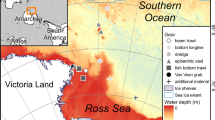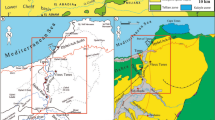Abstract
In bioerosion, as in trace fossils as a whole, deeply emplaced structures have greater survival value than shallow structures. That is to say, tiering (the relative depth to which rasping, etching and boring organisms penetrate their substrate) is of paramount importance for the preservation potential of individual trace fossils. An Entobia ichnofacies is established for trace fossil assemblages dominated by deep tier borings and arising from long-term bioerosion, such as occurs on sediment-free submarine cliffs or hardgrounds. A Gnathichnus ichnofacies comprises assemblages containing all tiers, including superficial sculptures produced by radulation that have very little preservation potential. Such assemblages occur in short-term bioerosion situations as on shell surfaces and hardgrounds buried early by sedimentation.
Similar content being viewed by others
References
Bottjer DJ, Ausich WI (1982) Tiering and sampling requirements in paleocommunity reconstruction. Proceedings of the North American Paleontological Convention. Vol. 1: 57–59
Bromley RG (1990) Trace fossils: biology and taphonomy. Unwin Hyman, London: 280 pp
Bromley RG (1992) Bioerosion: eating rocks for fun and profit. In: Maples CJ, West RR (eds) Trace Fossils. Short Courses in Paleontology No. 5. Paleontological Society: 121–129
Bromley, RG, Asgaard U (1991) Ichnofacies: a mixture of taphofacies and biofacies. Lethaia 24: 153–163
Bromley RG, Asgaard U. Endolithic community replacement on a Pliocene rocky coast. Ichnos 2: 93–116.
Bromley RG, Ekdale AA (1986) Composite ichnofabrics and tiering of burrows. Geol Mag 123: 59–65
Fischer R (1981) Bioerosion of basalt of the Pacific coast of Costa Rica. Senckenbergiana Maritima 13: 1–41
Frey RW, Seilacher A (1980) Uniformity in marine invertebrate ichnology. Lethaia 13: 183–207
Jarvis I, Bromley RG, Clayton C (1982) Sedimentology of the Suzanne Hardground, northern France: colonization and diagenesis of an early Campanian (Upper Cretaceous) seafloor [abstract]. International Association of Sedimentologists 3rd European Meeting, Copenhagen 1992: 15–16
Seilacher A (1992) Quo vadis, ichnology? In: Maples CJ, West RR, (eds.) Trace Fossils. Short Courses in Paleontology No. 5. Paleontological Society: 224–238
Wetzel A, Aigner T (1986) Stratigraphic completeness: tiered trace fossils provide a measuring stick. Geology 14: 234–237
Author information
Authors and Affiliations
Additional information
Correspondence to: R. G. Bromley
Rights and permissions
About this article
Cite this article
Bromley, R.G., Asgaard, U. Two bioerosion ichnofacies produced by early and late burial associated with sea-level change. Geol Rundsch 82, 276–280 (1993). https://doi.org/10.1007/BF00191833
Received:
Accepted:
Issue Date:
DOI: https://doi.org/10.1007/BF00191833




